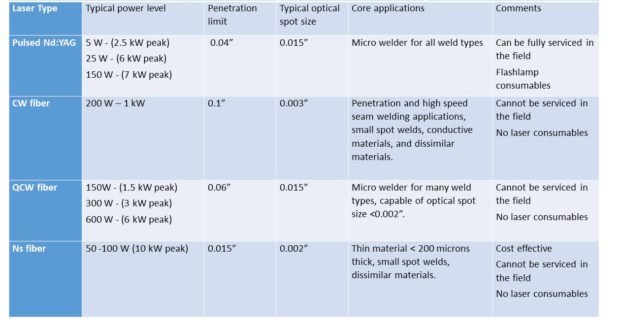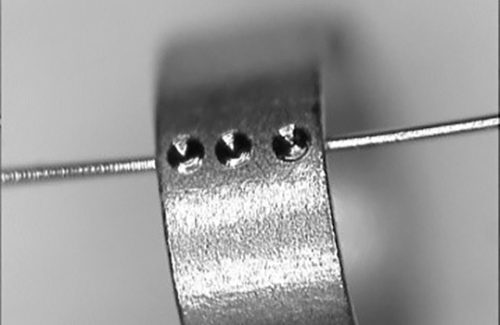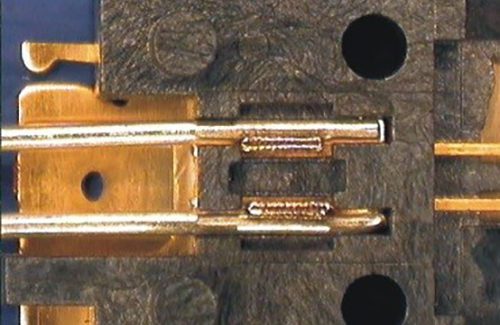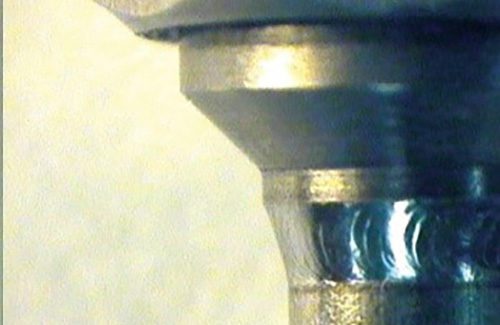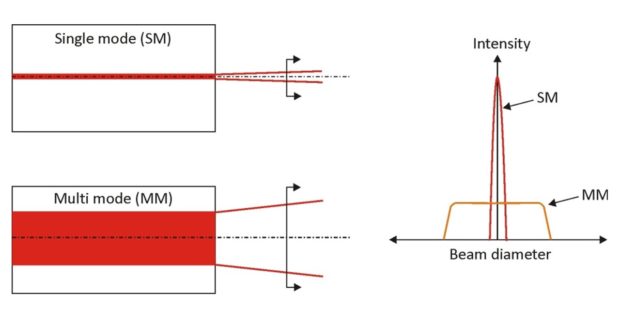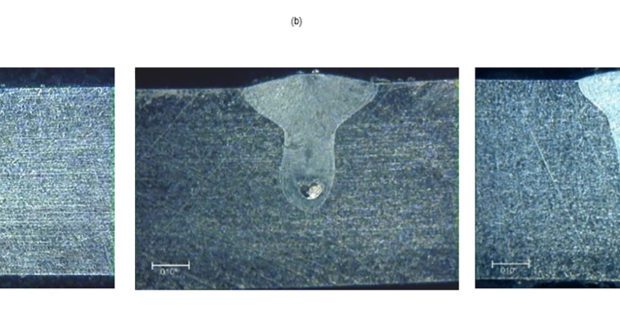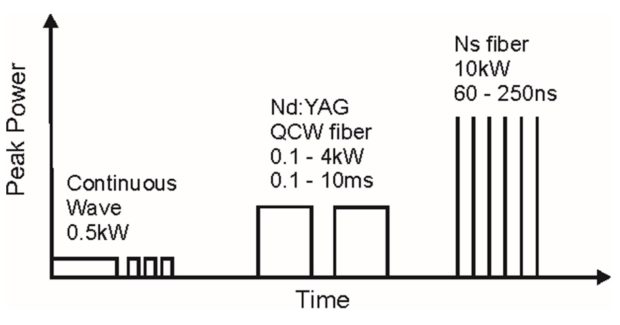Nd:YAG or Fiber Laser Micro Welding?
There are a number of choices for laser for micro welding. Here are the factors to consider why and when one laser might be chosen over another, and how to select the best option for your specific application.
Posted: February 17, 2017
Four lasers can be used for micro welding: pulsed neodymium-doped yttrium aluminum garnet (Nd:YAG), continuous wave (CW) fiber, quasi continuous wave (QCW) fiber, and nanosecond fiber. Each laser type offers unique features that work best for specific applications. Here is a comparison of the pulsed Nd:YAG laser with the three fiber laser options, and a discussion of why and when one might be chosen over the other. In some cases, several options may work; in that case, cost of ownership and serviceability can tip the scales.
ND:YAG – PEAK POWERS AND PULSE WIDTHS PERFECT FOR MICRO WELDING
With the Nd:YAG laser, the active gain medium is neodymium, which is doped into a host crystal of yttrium aluminum garnet. This solid rod of material is typically 0.1 in to 0.2 in diameter and around 4 in long. Micro welding Nd:YAG lasers are optically pumped using flashlamps and typically emit light with a wavelength of 1064 nm, but can be frequency doubled (532 nm, green). The laser’s optical design is relatively simple: its heart is the power supply that drives and controls the flashlamp voltage and allows precise control of peak power and pulse width during the laser pulse using internal optical feedback. With excellent pulse control, the Nd:YAG laser also offers high peak powers in small laser sizes, which enables welding with large optical spot size. This translates to maximized part fit-up and laser to joint alignment accommodation. An example is a 25 W laser that can provide 6 kW of peak power, sufficient to weld steel and aluminum with a 600 micron spot size.
The pulsed Nd:YAG laser has been around for many decades and has by far the largest install base. In today’s laser landscape, it is best suited to spot welding application under 0.02 in penetration and seam welding heat-sensitive packages (see Figure 1A, 1B, 1C).
FIBER LASERS – GREAT FOCUSABILITY WITH SELECTABLE BEAM QUALITY
A fiber laser is generated within a flexible doped glass fiber that is typically 10 ft to 30 ft long and between 10 microns and 50 microns diameter. Ytterbium is used as the doping element because it provides good conversion efficiency and a near one micron output wavelength, which matches well with existing laser delivery components. The laser is generated wholly within a fiber, so there is no need to align the medium to cavity mirrors, nor is it necessary to maintain optics and alignment as with the pulsed Nd:YAG laser. The very efficient lasing process means the fiber laser can be small, air cooled, and provide high wall plug efficiencies.
The fiber laser’s unique characteristics are its “focusability” and its range of range of beam qualities, which can be tuned for each welding application. The two ends of the beam quality spectrum are single mode and multi-mode: single mode is defined by a beam quality or M2 less than 1.2, while multi-mode is generally above M2 of 2. The mode defines how well the laser can be focused and the power density distribution across the laser (see Figure 2).
The differences between single mode and multi-mode lasers are shown in Figure 3. All welds are shown in 0.06 in thick stainless steel: (a) represents a 500 W single mode fiber laser with an M2 value of 1.2 at 300 ipm with a 30 micron spot size, (b) shows a 700 W multi-mode laser with an M2 value of 15 at 100 ipm with a 150 micron spot size, and (c) shows a 1 kW multi-mode fiber laser with an M2 value of 15 at 80 ipm with a 250 micron spot size.
Continuous Wave (CW) Fiber Lasers
For high speed seam welding applications, this laser is operated in continuous wave mode, which means that the laser output remains on until being turned off. For spot welding either a single weld or a seam, the laser output can be pulsed or, more correctly, modulated – turning the laser on and off rapidly. The CW laser’s peak power is the same as its maximum average power, so focused spot sizes are generally under 100 microns to attain sufficient power density for welding with power levels under 1 kW. Due to the small optical spot size, lap and fillet weld geometries are preferred. Butt welding is possible if there is good part fit-up or if a seam location vision system is used. An alternate is using a scan head that can create motion lateral to the weld direction, known as wobble, which can effectively widen the weld to decrease joint alignment sensitivity.
CW fiber lasers are well suited to general seam welding up to 0.06 in depth for a 500 W laser, high speed seam welding of same and dissimilar materials, and producing spot welds under 100 microns in diameter.
Quasi-Continuous Wave (QCW) Fiber Lasers
The QCW fiber laser’s peak power and pulse width characteristics are similar to those of the Nd:YAG laser, though the parameter range is not quite as broad. Similar to CW fiber lasers, the QCW lasers offer single mode to multi-mode options with spot sizes from 0.001 in to 0.04 in as needed for the application (see Figure 4). These lasers also shine in small spot size applications and penetration applications, although they do provide a fairly comprehensive coverage of many micro welding applications.
Nanosecond Fiber
The nanosecond fiber laser is a more recent addition to the lasers offered for welding. It is the same laser used for laser marking applications, and is a very cost effective solution that can be repurposed very effectively for certain welding applications. The nanosecond laser provides multi-kilowatt peak power, but with pulse widths around 60 nanoseconds to 250 nanoseconds that can be delivered between 20 kHz to 500 kHz. This high peak power enables welding of almost any metal, including steels, copper, and aluminum. The very short pulse widths enables very fine control for welding small parts, as well as the ability to weld dissimilar materials.
SUMMING IT ALL UP
While there are a number of choices for laser for micro welding, the CW fiber and nanosecond fiber have distinctive application specialties. Nd:YAG is the established source, with great all around micro welding capability; CW fiber lasers provide excellent speed/penetration characteristics and the ability to weld conductive and dissimilar materials; QCW fiber offers similar capability to the Nd:YAG laser, with additional small spot and penetration features; and finally, the nanosecond laser provides great control using sub 400 nanosecond pulses for thin materials and fine spot applications, as well as some dissimilar materials bonding. CW lasers are simply turned off and on as needed, but can be modulated to provide a pulsed output. Nd:YAG and QCW fiber are typically 0.2 kW to 4 kW peak power and 0.1 ms to 10 ms pulse width. Ns fiber lasers operate at around 10 kW peak power and 60 ns to 200 ns pulse widths (see Figure 5).
The most interesting match-up is the Nd:YAG and the QCW fiber laser, which offer similar welding capabilities: both have high peak power and millisecond pulse widths for large diameter (>200 micron) spot and seam welding. The Nd:YAG laser has been around forever and has a massive install base and end user familiarity, while the QCW laser is the relative newcomer with some strong cost of ownership features. From a welding perspective they are quite close; points of consideration that tip the scale are the cost of ownership and serviceability. The QCW laser does not use flashlamps, which reduces maintenance costs. The Nd:YAG laser is fully serviceable in the field. The choice then can become somewhat of an equipment preference, driven by whether the user requires a laser that is cheaper to run or one that can be maintained 24/7. Table 1 provides a general summary of the characteristics of lasers for micro welding. The information can be used to help guide which laser would be the best option for a particular application.

